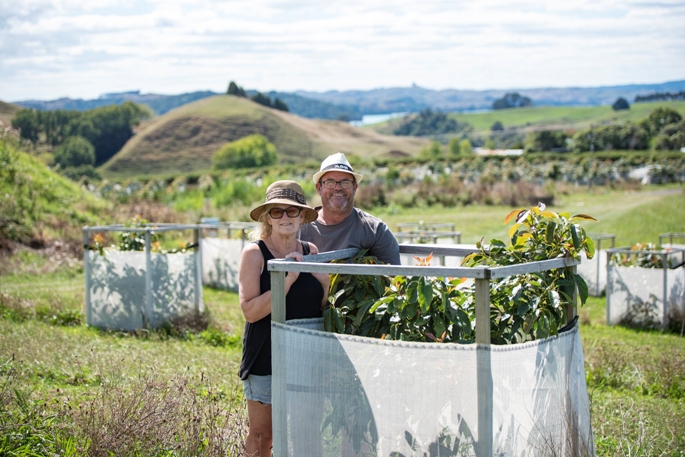As Jonathan Cutting and his partner Joy head towards their retirement, for the past five years they have been nurturing a new project that is close to their hearts. Their plans for their 75-acre block just outside Raglan are already well underway and don’t equate to the word retirement!
“We can’t retire at 65 and sit around and do nothing for 35 years!” says Jonathan.
South African-born Jonathan has been in New Zealand since 1993, and is widely considered as the country’s ‘go to’ man for technical advice around growing avocados.
Currently the avocado technical manager for Trevelyan’s Pack and Cool Limited in Te Puke, previous roles include a senior research fellowship at Massey, and 11 years as the technical manager/CEO of the New Zealand Avocado Industry Council.
“Over the years I’ve developed a wider philosophical view of agricultural practice in New Zealand.
“We pollute to produce and I want to try and work away from that practice.”
Cows to avos
The Raglan property was bought in 2016 after an extensive search of the North Island.
“It’s an undulating property with beautiful, deep red ash clay soil like Pukekohe, and lovely organic matter on the top.”
The property has bore water that is pumped for irrigation, plus several streams with quality water. It’s off-grid using solar power, has a barnand several retirement house sites to choose from.
The couple’s intention is to move completely away from current avocado orchard practices, and trial growing avocados using regenerative farming principles. They are viewing the whole 75 acres holistically, with only 10 acres actually planted with avocados.
“To farm regeneratively on 10 acres, you need much more land available than that.”
They have already planted 800 avocado trees with the oldest approaching two years old, and they intend to plant 1200 in total.
Currently in frames and swathed in wind cloth, the trees are trimmed around three to four times a year, so they remain four metres apart, no more than 2.5 metres wide or 3.5 metres tall. The cloth can be removed at three years and the frames at five years.
Once mature, the trees will resemble a hedgerow between the eight-metre wide mowed rows, providing easy access picking.
“This type of high density pruned orchard is not too labour intensive, around three man days per hectare a year.”
The elevated position and the resulting wind is a big issue for the young clonal root stock avocado trees. With no tap root, they blow over easily until the roots establish.
The two-year-old Japanese cedar (cryptomeria) shelter belt trees are already pushing three metres. Thousands of manuka trees have been planted to overshadow gorse on the property.
The ex-dairy farm land was overgrazed and degraded, with woolly nightshade, gorse and Californian thistle, and herbicide was required initially, with the intention to move away from that going forward.
The avocado trees themselves are Hass, on the new clonal root stocks like SR1 and Latas that are available, and around 12 percent are pollinator trees. Jonathan and Joy have had their own beehives since 2014.
“We started our first hive in the yard of a town house in Mount Maunganui and now we have 300 hives out each season,” says Jonathan.
Their own hives are dotted around the Raglan avocado trees, as bees remain a crucial part of the avocado life cycle.
The ground under the trees is manually kept weed free, and has a topping of alfalfa, woodchip and horse manure. Species such as squash, peas, beans, borage, plantains, chicory and vetches can be seen growing between the plants.
“They add to the biodiversity of the soil, add nitrogen, reduce compaction and encourage fungi, while providing a safe environment for predator insects that prey on pests that target the avocados.”
All about soil
A cage of young guinea fowl will be released onto the land to breed naturally and assist with pest control.
“I hatched them myself in an incubator in our Mount Maunganui apartment,” says Joy.
Other plans for the land include breeding their own small scale Hereford herd and feeding them diverse pasture mixes, and planting the rest of the farm with hardwood trees such as Tasmanian blackwood, totara and rimu.
The wetland areas will be planted with two to three thousand kahikatea and kauri.
Jonathan and Joy are moving forward with an open mind. While wanting to explore and experiment with regenerative methods, Jonathan says they would spray or use traditional fertiliser if the traditionally high value crop was economically at risk.
However, as regenerative farming is all about the soil and its health, this will be the focus going forward.
“This is a journey and the most rewarding destination I can hope for would be tried and proven methods for growing avocados with less pollution, less environmental impact, and less extractive methods.
“I would like my research to contribute to a future that means all New Zealand avocados are successfully grown this way,” says Jonathan.



0 Comments
Leave a Comment